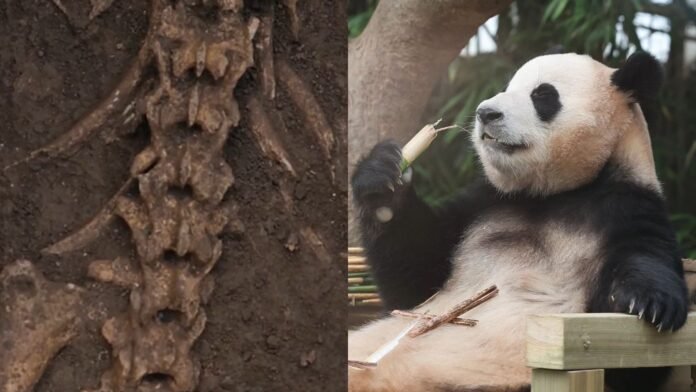The location of Emperor Wen of Han’s mausoleum, the Ba Ling, had been a mystery for millennia, until archaeologists successfully confirmed in December 2021 that the true identity of the large tomb at Jiang Village in the Bai Lu Yuan of Xi’an City, Shaanxi Province, was indeed the Ba Ling. Recently, during the excavation of the animal sacrificial pit on the west side of the Ba Ling, a complete skeleton of a giant panda from over 2000 years ago was unearthed. Experts have claimed this to be the first discovery of a giant panda used as a burial accompaniment.
According to Shaanxi TV News, ancient people had precedents of using warhorses, dogs, and even monkeys as burial accompaniments. The recent archaeological work has uncovered that Emperor Wen of Han, from over 2000 years ago, had the national treasure, the giant panda, as his burial accompaniment.
The report indicates that during the excavation of the animal sacrificial pit on the west side of the Ba Ling, a giant panda skeleton from over 2000 years ago was discovered. Researcher Hu Songmei from the Shaanxi Provincial Archaeological Research Institute explained that this is a complete skeleton of a giant panda, its head directed towards the imperial mausoleum, tail to the west. This is likely a panda from the northern slope of Qinling, and the first such discovery within a tomb.
Emperor Wen of Han, Liu Heng, was an illegitimate son of Liu Bang, the founder of the Han Dynasty. He ascended the throne in 180 BC, and is known in Chinese history as a wise and just ruler. His reign, together with that of Emperor Jing, is referred to as the “Rule of Wen and Jing,” which laid the groundwork for the great Emperor Wu to elevate the Han Dynasty to its zenith. However, the location of this wise emperor’s mausoleum, the Ba Ling, was a “millennia-old mystery” until 2021, when it was finally confirmed by the State Administration of Cultural Heritage to be the large tomb in Jiang Village in the Bai Lu Yuan of Xi’an City, Shaanxi Province.
Before the identity of the tomb’s owner was confirmed, the tomb in Bai Lu Yuan in the eastern suburb of Xi’an City, Shaanxi Province, was referred to as the Jiang Village Large Tomb. In 2016, the tomb’s outer storage pit was disturbed by tomb robbers. This led archaeologists to investigate and explore the Jiang Village Large Tomb and nearby Empress Dowager Dou’s Mausoleum, Empress Bo’s Southern Mausoleum, and the “Phoenix Beak” site believed to be Emperor Wen’s Ba Ling, and conduct archaeological excavations on the outer storage pits of the mausoleum.
Experts successfully ruled out the possibility of the “Phoenix Beak” being the Ba Ling, and due to the form and scale of the Jiang Village Large Tomb aligning with the highest standards of Western Han Dynasty tombs, coupled with the proximity of Empress Dowager Dou’s Mausoleum and Empress Bo’s Southern Mausoleum, they confirmed that the Jiang Village Large Tomb was indeed the Ba Ling.
The report states that Empress Dowager Dou’s Mausoleum is about 800 meters northeast of the Ba Ling, and Empress Bo’s Southern Mausoleum is about 2000 meters to the southwest. The Ba Ling is shaped like the character ‘亞’, without earth sealing on the surface, the tomb chamber is approximately 72 meters on each side and more than 30 meters deep, and there are over 110 outer storage pits around the tomb chamber. Traces of a wall around the imperial gardens were found around the Ba Ling and Empress Dowager Dou’s Mausoleum, suggesting that they were part of the same large imperial garden, which was about 1200 meters long east to west and about 863 meters wide north to south.
